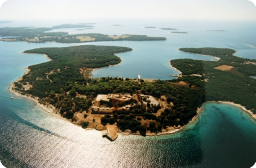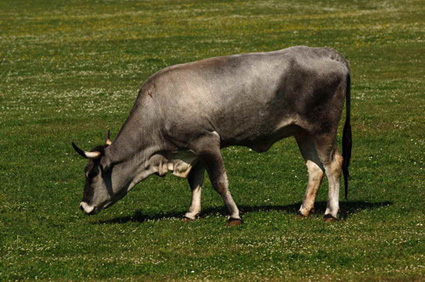

Brioni National Park
Brioni National Park  Ethno park
Ethno park
The ethno park is an area within the safari park and presents a typical Istrian homestead with its autochthonous animal species: the Istrian ox (Boškarin), Istrian sheep (Istrian Pramenka), donkeys and goats.
It is intended both as a habitat and a presentation of the domestic animals of Istria. You can also see the structures suitable for such farm animals, such as the Istrian open tetoja (a covered area with troughs for farm animals).

ISTRIAN OX
Can the Istrian ox be classified as a descendant of the auroch?
There are many theories about the origin of the Istrian ox or Boškarin. Some believe that it belongs to the breed of Podolac cattle that were brought to Istria with the Roman legions in the first centuries AD. A well-known fact is that the hordes led by Attila, king of the Huns, in 452 brought Podolac cattle with them into these areas. Based on the remains of wild cattle from Istrian caves, which are over 10,000 years old, scientists claim that the Istrian ox is a lineal descendant of the wild European auroch.
The Istrian ox is large-bodied with a heavy skeleton. It belongs to the group of primogenital cattle. Its colour is light or dark grey, with shades of darker pigment, most often spread over the neck, shoulders, stomach and parts of the face.
The head is elongated, with lively black and gentle eyes. Dark hair covers its auricles, and the lower and inner part of the tail.
A special feature for recognising this breed is the pigmentation on the palate and dark grey tongue. Its horns are grey or greyish-yellow at the root and usually black at the tips.
At birth, calves have reddish-brown coats, but when they are three months old the colour changes to grey. The Istrian ox reaches its maturity (full growth) at the age of six. This breed has adapted well to the karst region and local climate, as well as the sparse pasture. It is a sturdy, calm and untiring work animal, so that in Istria it was commonly used for ploughing fields or as a beast of burden for up to 20 years.
According to FAO criteria, the Istrian ox is on the verge of extinction.
ISTRIAN SHEEP
The Istrian sheep comes originally from the Mediterranean sheep that was brought to Istria in the past. It's probable that this breed also developed from the Istrian Pramenka breed. The breed can be divided into large-sized (southern Istria) and small-sized sheep (Labin area and eastern Istria).
Regardless of the different theories about the origin of this breed, it is certain that a more developed sheep giving a larger amount of milk has emerged in this geographically isolated area.
Sheep with an aristocratic appearance and Greek profile
Already at first glance, the Istrian sheep differs from other breeds. This breed of dairy sheep is characterised by its large and longer body with elongated extremities. The basic colour of its fleece is white, which is thickly covered with different sized black spots and patches. Their heads are often covered with patches, mostly black, but also fawn coloured or brown.
The Istrian sheep is primarily raised for the production of milk. During the milk production period (lactation), which lasts 210 days, it yields 135 to 145 litres of milk. Some sheep yield even more than 200 litres, which indicates their productiveness. Given the high milk output, 15 to 20 kg of cheese can be produced from each sheep. The typical produce of Ćićarija is a hard sheep's cheese known as ćićarski cheese. This cheese is traditionally made in a cheese kettle and the curd is broken up and stirred with a special paddle called a paklenara. After being lifted from the kettle, it is stored on a lesnice. The cheese requires about 20 days to mature, after which it is delicious to taste.
Source: http://www.brijuni.hr/
Video
Current news
 Macrocruise charter agency
Additional discount on the boat rental price of betw
Macrocruise charter agency
Additional discount on the boat rental price of betw





























